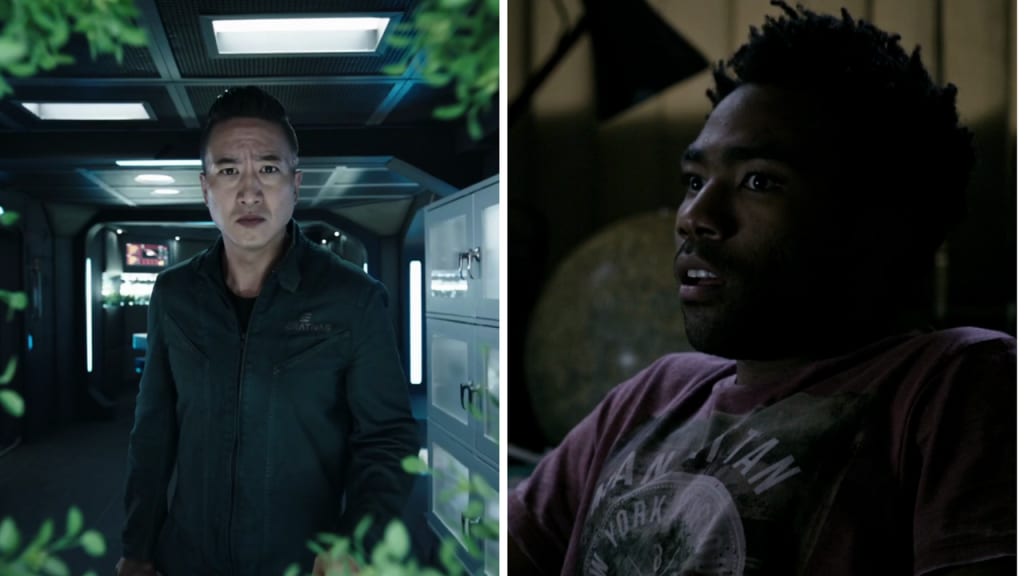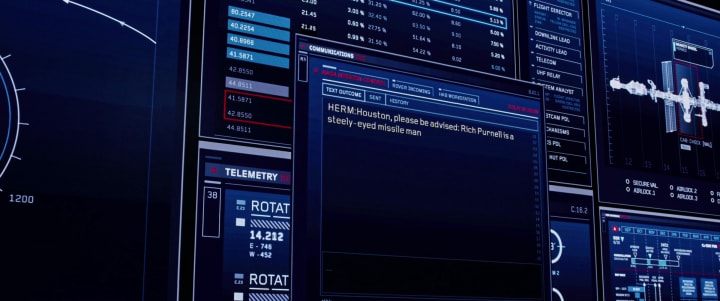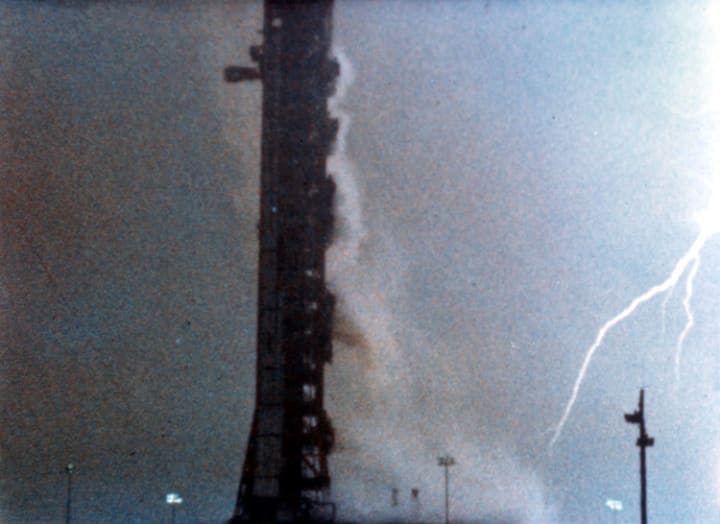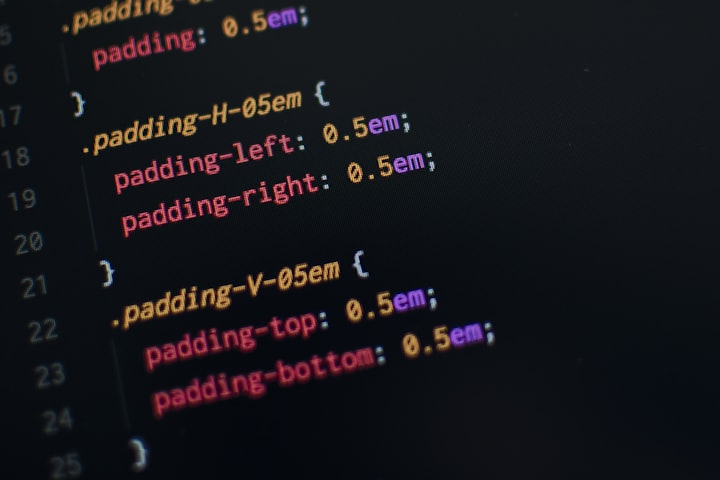Who Are the Steely-Eyed Men of Sci-Fi?
The history behind the science fiction.

The term steely-eyed missile man is a complementary term rooted in NASA's Apollo history when flight controller John Aaron's quick thinking saved the Apollo 12 mission from disaster. It refers to an engineer or astronaut who quickly devises an ingenious solution to a tough problem while under extreme pressure.
The term has cropped up in SyFy's The Expanse and the 2015 film The Martian. Why exactly have script writers chosen to refer to this particular event in NASA's history and what makes the characters in these stories "steely-eyed men?"
The Steely-Eye Man of Science

The botanist Prax discovers how to defeat the protomolecule hybrid.
In The Expanse's season two finale, "Caliban's War," Praxidike Meng (Terry Chen) and the crew of the Rocinante must find a way to remove the human-protomolecule hybrid from the ship. Fortunately for the crew of the Roci, Prax is a botanist and he realizes that, like all living organisms, the creature follows certain constraints. Figure out what those are, you figure what guides the hybrid's behavior. Do that and they just might get it off their ship.
Prax's experience as a botanist on Ganymede Station helps him realize that the hybrid seeks and moves toward the raw energy it needs to survive. In the same way a plant grows toward the light, the hybrid follows a nutrient gradient. Manipulate this "gradient" by giving the creature a yummy food source and they can lure the hybrid outside the ship.
In this case, the yummy snack is a radioactive nuke which Prax uses to lure the creature outside. Pilot Alex Kamal (Cas Anvar) then uses the Roci's afterburners to destroy the creature. The success of Prax's plan leads an excited Alex to declare:
This is one steely-eyed man of science, our plant guy!
And it is arguably a title well-earned. It is difficult solving tough problems when an evil protomolecule is trying to kill you.
The Purnell Maneuver

Rich finally solves that tough problem
If the reference sounds familiar, you may have heard it in the 2015 science fiction film The Martian. JPL astrodynamicist Rich Purnell (Donald Glover) comes up with the slingshot maneuver that could enable the Hermes crew to go back to Mars to pick up Mark Watney (Matt Damon) and save the stranded astronaut's life. This maneuver would eventually be called "The Rich Purnell Maneuver."
The idea behind using Earth to slingshot the Hermes spacecraft is a brilliant one. In the movie, NASA was faced with the problem of keeping Watney alive. They could use the secret Chinese probe, the Taiyang Shen, to send enough supplies to Mars, or they could resupply the Hermes and reroute the craft to Mars. The longer Mark stays on Mars, the more likely he dies there. While sending the Hermes back will add an extra 533 days to their mission, it brings the stranded Mark back sooner.
Coming up with the answer was not easy and neither was the decision to go back - it meant the Hermes crew would have to defy NASA. In recognition of this, once the decision had been made, the Hermes responded:
Houston, please be advised: Rich Purnell is a steely-eyed missile man.
A fitting nod of respect to the gifted engineer.
The Real Steely-Eyed Missile Man
The term "steely-eyed missile man" has its roots in the Apollo 12 mission and it is a pretty exciting story. Many people are familiar with the near-disastrous Apollo 13 mission but Apollo 12 was also a near-disaster though not as dramatic.
Apollo 12 was the sixth manned flight in the Apollo program and the second to land on the Moon. Soon after the November 14, 1969 launch from the Kennedy Space Center, the vehicle was struck by lightning, not once but twice. The November 1969 mission was a wet one, taking place during a rain storm. Mission rules suggested such a scenario should be avoided but lead flight director Gerry Griffin decided to launch.

Lightning strikes around launchpad shortly after liftoff of Apollo 12. (Credit: NASA)
Thirty-six-and-a-half seconds after liftoff, the rocket triggered a lightning discharge that traveled through itself and down the ionized rocket plume. Navy Captain and mission commander Pete Conrad had no idea what happened. All he could see was that all caution and warning lights were going off.
The fuel cells, which supplies power to the Command Module's computers, were knocked offline by the lightning strike. The strike also affected the circuits that connected the spacecraft's systems to their power supplies. With no power, the Command Module switched to the reentry batteries. These batteries were only intended to be used during the last hours of the final phase of the mission where the Command Module separated from the Service Module and reenters the atmosphere for an ocean splashdown. They did not have the necessary power to maintain the current needed for the Command Module.
They say lightning never strikes twice. In this case, it did. A second strike fifty-two seconds knocked the "8-ball" attitude indicator offline. Though telemetry data from the spacecraft was distorted and garbled, the vehicle continued to fly correctly. It looked as if the decision to abort was obvious and everyone waited for the Electrical, Environmental and Consumables Manager (EECOM) John Aaron to make the call. Instead, he did something unexpected. He said:
Flight, EECOM, try SCE to 'Aux'.
The pattern of lights looked familiar to Aaron. One year earlier, he had noticed a similar pattern during a test when the a power supply malfunctioned in the Signal Conditioning Equipment (SCE). This piece of equipment scrubs and cleans data, converting the raw signals from the craft's instruments to voltages the craft's instrument display can use. Switching the SCE to Aux switched the SCE to a backup power supply, essentially resetting the system.
This switch was so obscure, almost no one recognized it - Aaron had to repeat the command several times. Luckily, Lunar Module Pilot Alan Bean, who happened to be sitting in the right seat, remembered the SCE switch from a training incident when the same failure had been simulated. It was Aaron's ability to identify a problem and quickly solve it, as well as Bean's memory that prevented an aborted mission and earned Aaron the reputation of "steely-eyed missile man."
The Highest Compliment
Calling someone a "steely-eyed missile man" is one of the highest compliments that can be paid to a member of the space community. It means that person has solved an extremely difficult problem under the most challenging situations. So when Prax figures out how to lure the hybrid out the Roci, and when Rich figures how to get Watney home before his food runs out, they continue the spirit of the NASA legend of becoming "steely-eyed missile men." Both characters make reference and pay tribute to that NASA tradition.
About the Creator
David Latchman
Science writer and blogger. Owner of the Science vs. Hollywood (www.sciencevshollywood.com) website - a blog that looks at the intersection of science and popular culture. Follow me on Twitter @sciwriterdave or @scivshollywood







Comments
There are no comments for this story
Be the first to respond and start the conversation.